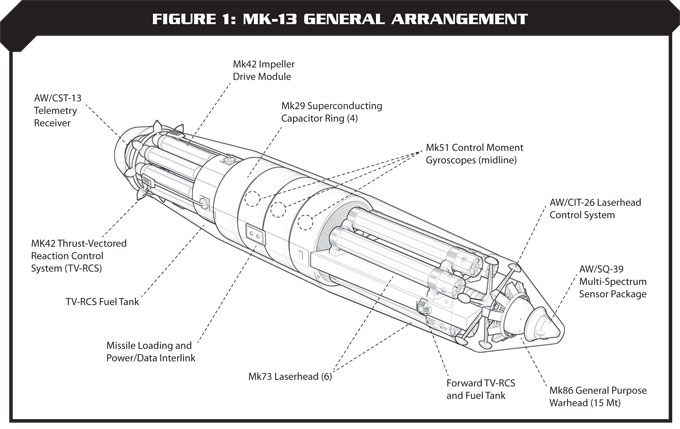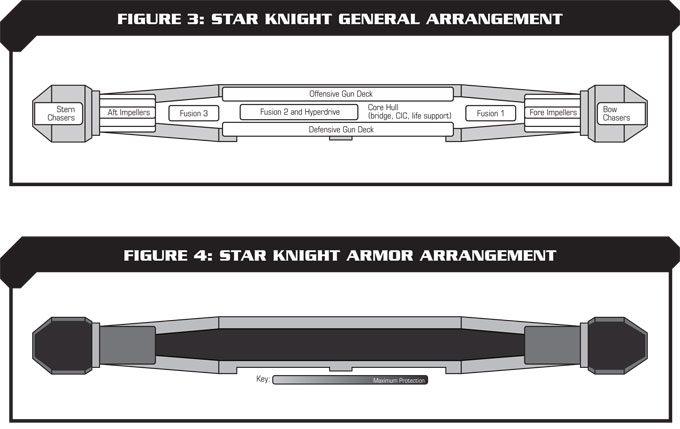In Fire Forged: Worlds of Honor V-ARC (50 page)
Read In Fire Forged: Worlds of Honor V-ARC Online
Authors: David Weber
Tags: #Science Fiction, #General, #Space Opera, #Military, #Fiction

A related ship design choice gave the
Star Knight
a truly astonishing second redundant fusion reactor above the normal one. Each reactor is alone capable of carrying the full combat load of the ship and the addition of a second spare at considerable cost in mass is a good indication that the design team was dedicated to ensuring that the sidewall generators continued to receive power no matter what. Ongoing criticism of the design’s defensive emphasis cast doubt on the utility of this particular innovation.
The
Star Knight
’s armor scheme shows features common in heavy cruisers and quite a few borrowed from battlecruiser and capital class units. A general declassified arrangement of the armor system appears in Figure 4 (see end papers) as available on public datanets and enhanced by the author. Key armor system features are described below.
General Outer Hull Armor
The skin of the
Star Knight
’s outer hull on the broadside has an armor system probably consisting of scattering layers of structural gels sandwiched between ceramic boundary layers. Due to the massive area covered by the general armor, it is likely built on a cheap abundant silicon substrate which means silicon carbide would be the ceramic of choice for boundary layers. The outer hull is generally fifteen or twenty meters from the vital systems in the core hull. Hence, a beam scattered on impact with the outer hull armor has fifteen to twenty meters to spread out before contacting the core armor. Public sources estimate that the outer hull is armored to a thickness of some half a meter or more. Localized specialized protection such as the impeller room belts tends to be grown or layered on top of the general outer hull armor substrate.
Hammerhead Armor
Without benefit of sidewalls, the hammerheads are usually the single most heavily armored portion of a warship’s exterior hull. Unofficial estimates from Jane’s and other open source intelligence indicate that over half of a
Star Knight
’s armor mass might go to hammerhead armor. External holo inspection indicates an armor depth upwards of a meter in some places, though the sloping portions probably have less thickness than the vertical faces. Some sources report the use of a heavy metal additive as a boundary layer absorption enhancer in the outer surface hammerhead armor. The most common material for this purpose would be silicon or carbon based nanocomposite weave loaded with high concentrations of iron. Research papers by firms known to have been employed by BuShips while
Star Knight
class was being designed, however, described experiments doping silicon structural gels with tungsten, lead, and osmium. These have led to speculation that these materials may have been used in
Star Knight
’s armor. Such additives, if used, were probably a mass saving measure though they would also provide modest increases in graser resistance in thicknesses above a few centimeters. Another oft-commented feature is the bow hammerhead’s longer and more angular shape compared to the stern’s. This is due to key structural members which must run from the impeller rings forward to brace them under acceleration. The longer, sloping portion of the bow hammerhead armor envelope encloses the forward set of structures while those at the stern are covered by the impeller room belts.
Core Armor
When the core hull of a starship has at least one dedicated protective anti-beam or kinetic layer, it is said to have core armor. Core armor is a universal feature on anything larger than a battlecruiser but less common on smaller ships. The
Star Knight
’s core armor encloses all vital systems that can fit within its envelope, including the vast majority of crewed spaces, power rooms, control spaces, and virtually the entire life support complex. The composition is probably similar to the hammerhead armors. The core hull itself is of course difficult to see in most imagery so the thickness of its armor is uncertain, but it probably at least half a meter. Given the location of external fueling and venting ports, it is likely that the fusion reactors are surrounded by layers of compartmentalized hydrogen bunkerage for extra protection.
Impeller Room Belts
While the hammerhead armor provides some protection to the impeller room from raking shots, broadside protection is also necessary. These belts are the second most common armor feature after hammerhead armor and are known galaxywide by designers and damage controlmen alike as “the fore and after belts.” They consist of thick armor just below the outer skin of the ship and extend aft/forward from the associated bow/stern hammerhead. The lack of any visible penetrations, airlocks, seams, or ports from the impeller rings forward and aft to a point about halfway along the taper of the hull probably gives a good indication of the length of these belts. There are no external seams which might give a rough estimate of the depth of the belts at these points, but they are probably thinner than the hammerhead armor given that they are protected by a sidewall and rad screens. A total depth of roughly three quarters of a meter is probably close. This belt is likely dense with absorption enhancers in the outer surfaces and possibly even face mirroring.
General Engineering Belts
Also known as “fusion belts” these are broad area armor over vital machinery in way of the fusion reactors. This armor is in the bow and stern tapers and provides protection for the fusion reactors and other nonpropulsion engineering auxiliaries such as heat exchangers, coolant transfer lines, damage control remotes, and secondary power systems. These belts are usually about the same diameter as the impeller belt. Figure 4 shows both how the belts sit some distance inside the outer hull envelope and how they are centered on two of the three fusion reactors. The space between the engineering belt and the hull leaves room for nonessential spaces such as the captain’s day cabin, whose windows are visible on the starboard side of the after hull taper in some file holos. The redundant third reactor and the placement of all reactors within the core armor probably mean that the engineering belts are thinner than the impeller belts to save mass.
Gundeck Belts
Frequently called simply “the gun belts.” these armor layers sit on the outer skin of the ship on the upper and lower curves of the hull and act to limit damage to the offensive and defensive armament, magazines, and sidewall generators. These belts would be rated successful if a hit by an opposing beam destroyed only the weapon directly behind the armor and not others. Extensive mount by mount compartmentalization is required behind the armor to ensure this. The gundeck belts are laid over the basic outer hull armor matrix and likely consist of additional high density boundary layer materials grown onto silicon carbide substrate. This additional material appears to thicken the belt by roughly ten centimeters.
Conclusion
This concludes our introduction to modern starship armor design. This area is still sadly misunderstood even among naval enthusiasts. It is hoped that this article provided the reader with insight into how combat starships are built so that their operations might be better understood. The available time and space meant that fundamental concepts such as compartmentalization, relativistic effects, lateral armored bulkhead placement, and control run protective features had to be omitted. The author intends to continue his research, exploring these subjects as well as finalizing armor and laser interaction codes of his own design. It is hoped that these codes, derived entirely from open source high energy density physics research, will appear in subsequent issues of this periodical and be useful tools to his fellows.
Appendix: Armor Design Figures


